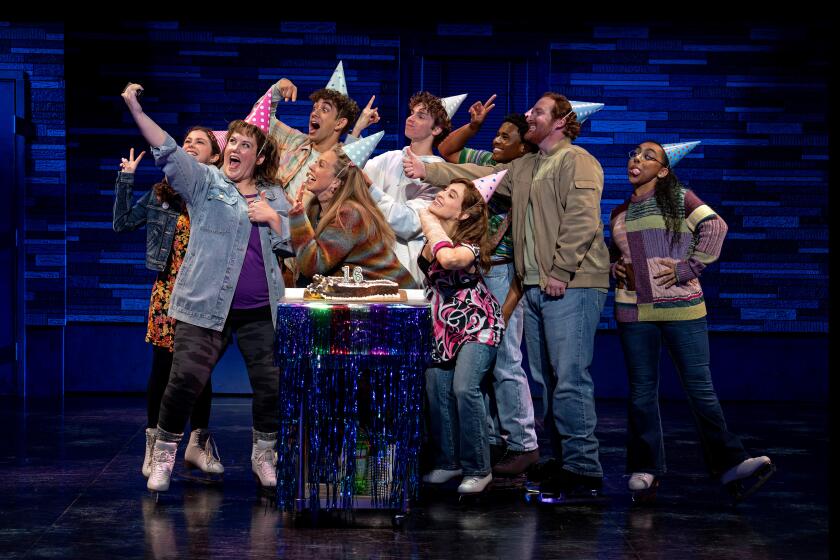ART REVIEW : A Tale of Cultural Continuity at Getty
When reality is in flame and mobs rule the streets, the arts seem almost laughably useless. An exhibition called “Italian Master Drawings,” just opened at the J. Paul Getty Museum, spans time from the Renaissance through Neoclassicism. It reminds us that art is, in fact, much more than merely ornamental. The arts don’t just offer distraction, they knit up the sundered social fabric giving continuity to times that seem chaotic.
The Renaissance itself was violent and corrupt. It ended when a crisis of faith triggered the Protestant Reformation. It must have seemed the world was crumbling then as it does now. Instead, in the fullness of time we see that the challenge to the old order inspired a magnificent new way of seeing the Baroque.
The Getty exhibition is not large, just 24 sheets of paper installed in a room dimly lit to protect them. That alone is a reminder that there is much worth cherishing in this civilization, not just rare and precious objects but the ideas they represent. Some of these seem to speak directly to us today.
Giovanni Bellini was among the greatest artists of 15th-Century Venice. Only a handful of his drawings survive. The one here is called “Fortitude.” In it a young woman struggles against a ferocious lion. It is clearly about the need for the spirit of peace and rationality to finally prevail against rage.
Titian succeeded Bellini as Venice’s grand master of painting in the 16th Century. He is represented by “Nude Man Carrying a Rudder on His Shoulder.” At the time, the image was a well-known symbol of civic consistency. The ship of state does not steer the man, the man steers the vessel, his fate, himself.
Domenico Fetti had a brief career in Mantua and Venice after being influenced in Rome by the aggressive art of Caravaggio. There is an unexpected decorative lilt to his “David With the Head of Goliath.” Maybe it comes from that abiding faith that, when he’s right, the little guy finally wins.
The solace of these drawings runs deeper than handy symbolism. Drawings are quite literally about the way we see things. In the midst of all the nasty, interminable little wars between the autocrats of the Italian city states, its artists were developing a new vision, celebratory of humankind, its capacity for rational equilibrium and scientific curiosity.
Andrea Mantegna brought a surgeon’s probity to his pioneering investigation of three-dimensional space. Leonardo da Vinci came to embody the world’s idea of Renaissance genius--multifaceted and omnivorous. His penetrating detachment joins his capacity for tenderness in his tiny “Three Sketches of a Child With a Lamb.” It was a study for a painting now lost. Some drawings are all that is left of works that disappeared or were never realized.
Late in the exhibition we encounter a colored drawing by Felice Giani that was supposed to grow into a monument to the sculptor Canova. An elaborate architectural fantasy by G. B. Piranesi represents a visionary scene of a crushingly magnificent pile of classical architecture that could never have been built outside the haunted grandiosity of the artist’s imagination.
With Raphael we are luckier. His graceful study of male figures contributed directly to one of the world’s great cycles of painting, the “Disputa” from the frescoes in the Vatican’s Stanza della Segnatura. But very often artists had assistants on such large projects. Only in drawings do we have the artist complete, testifying to the fundamentally personal source of all ideas, both magnificent and malevolent. Realization of the personal suggests we pursue our own highest aspirations and remain skeptical of all imposition of higher authority. After all, that “law” was just somebody’s idea.
Institutions forget that and atrophy into monoliths. The Baroque would eventually become the Academy but in the beginning it had the energy of an uncorked genie. The Classical Baroque was invented by the Carracci brothers. Here, Agostino’s study of a kneeling man is a fresh and felicitous combination of structure and sensuality. Annibale’s study of a triton blowing a conch shell is too much blowzy fun to be pompous.
G. B. Piazzetta’s “Boy Holding a Lemon” may be the best drawing in the show. Its earthy caress of smooth skin, sparkling eyes and warm air looks like something out of a sexier version of the French Enlightenment.
It is impossible to look, then think, about what all this means in the annals of human progress and not be cheered. But politically correct puritans are sure to finger this work as just more historical baggage from the hands of a bunch of dead white males.
They are to be reminded that when Italians came to these shores as immigrants they were a scorned minority. Now they are part of the American fabric. People from all cultures deserve the same. All of them are bearers of great cultural traditions.
* J. Paul Getty Museum, 17985 Pacific Coast Highway, Malibu to July 19, closed Mondays. Advance parking reservations required. (310) 458-2003.
More to Read
The biggest entertainment stories
Get our big stories about Hollywood, film, television, music, arts, culture and more right in your inbox as soon as they publish.
You may occasionally receive promotional content from the Los Angeles Times.










